This amazing vegan pad thai is made with rice noodles, tofu, mushrooms and vegetables tossed in a tangy homemade pad thai sauce. Our recipe is full of tips to help you make this beloved Thai street food successfully at home.

Table of Contents
History of pad thai
Pad Thai is perhaps the most well-known dish in Thai cuisine. But did you know that it is actually a dish with more recent origins?
Historians suggest that Pad Thai was made popular in the 1930s, promoted by the government as a dish to galvanize the nation.
With its stir-fried noodles, some also suggest it to have Chinese origins. It is believed that rice shortages at the time also led to its popularity, as rice noodles were more economical.
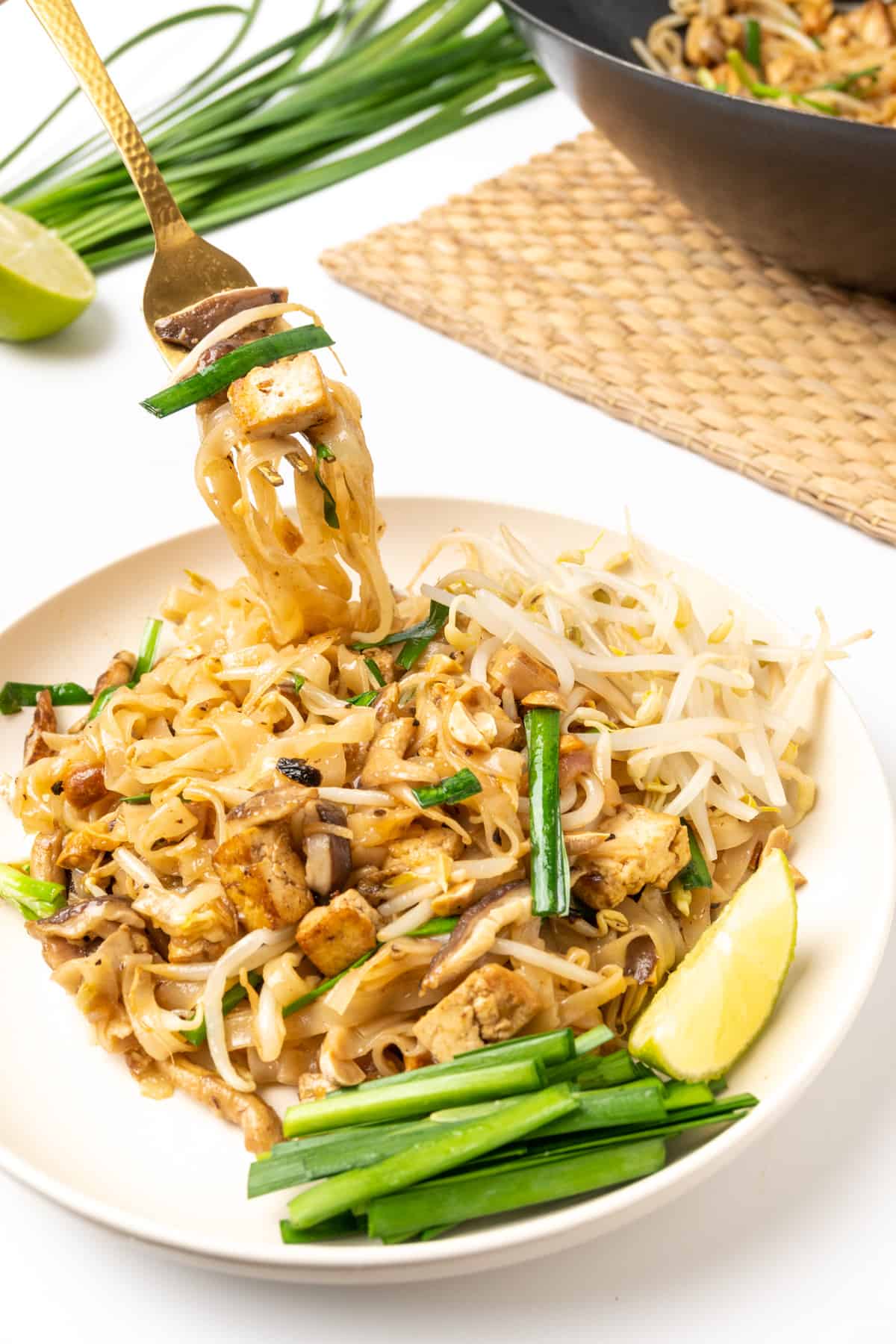
Today, Pad Thai is hugely popular, whether served as street food in Thailand, or in one of the many Thai restaurants around the world.
But how do you make pad thai vegan, and how can you make it at home? Let us show you how!
Ingredient tips
Here’s what you’ll need for this yummy vegan version of pad thai:

Rice noodles - The best pad thai noodles are flat and about 2-3 millimetres wide. They may also be described as medium size or ‘sen lek’ noodles. Look for dried white or brown rice noodles. They need to be soaked before cooking.
Tofu - You want to use extra firm tofu so it holds together well during stir-frying.
Shiitake mushrooms - This is not an ingredient in a traditional pad thai recipe, however, their addition brings umami and adds a nice textural component to this vegan version.
Tamarind concentrate - This ingredient is responsible for the characteristic tangy taste that pad thai has. We recommend looking for a Thai brand of tamarind concentrate, as Indian tamarind is very different.
Tamarind can vary in sourness so you may need to adjust the amount of tamarind to suit the brand you have. If when you taste it, the tamarind is lip puckeringly sour, you may want to use less to make the sauce.
Vegan fish sauce - If you want to make vegan or vegetarian pad thai, you’ll need to replace the traditional fish sauce that it contains. We used a storebought vegan fish sauce containing seaweed.
Palm sugar - This is a type of less refined sugar common in Thai cuisine. It has a golden brown colour and caramel flavor. It often comes in blocks or domes, which should be chopped or grated before use.
Peanuts - These are roasted or toasted to add their delicious crunch to the dish!
Bean sprouts - For adding a refreshing crunch to the pad thai. Use them as fresh as possible as they don’t store well.
Garlic chives - These are a type of green herb common in Asian cooking. You may also find them called Chinese chives.
You’ll also need: oil, soy sauce, shallots, garlic and chilli flakes / red pepper flakes.
Substitutions
We highly recommend sticking to the recipe for the best results and to stay close to the authentic pad thai taste.

However, we know it can be difficult to get some of the specialized Thai ingredients, so here is a list of possible substitutions and alternatives you can try.
When making substitutions for any of the sauce ingredients, you may need to make adjustments to the other ingredients to get the right balance of sweet, salty and sour in the pad thai sauce.
Tamarind - Lime juice is the most accessible substitute that helps provide some of the sourness that tamarind provides, but it will taste different. Pomegranate molasses is said to be most similar to tamarind paste in taste, but we have not tried it.
Palm sugar - Light brown sugar is the easiest alternative - you can use an equal amount as a substitute. Other recipes also sometimes use maple syrup or coconut sugar.
Vegan fish sauce - Our favourite alternative to vegan fish sauce is an equal mix of soy sauce and white miso paste, which creates a salty, tangy and fermented mix that works well as an easy sub. You can also make your own vegan fish sauce, or use only soy sauce if that’s all you have available.
Garlic chives - Wild garlic leaves are a close substitute to the flavour of garlic chives. You can also use regular chives. Scallions (aka green onions) or spring onions can also be used as an alternative but will give more of an oniony flavour. As they are larger and less mild, just a few scallions will do.
Shallots - You can use half a medium yellow or red onion in place of the shallot.
Step by step
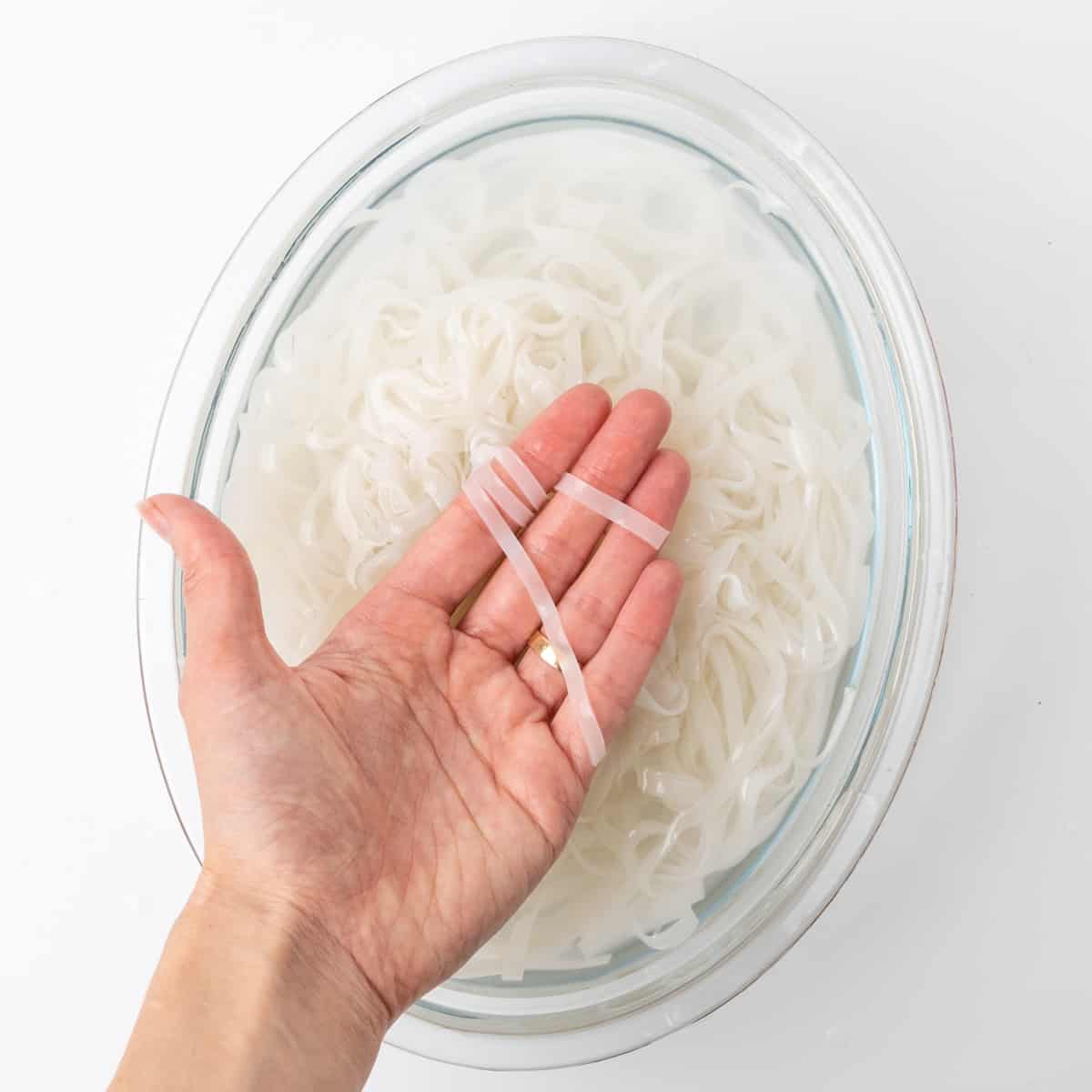
Step 1 - Soak the noodles according to the package instructions for stir frying.
Tip!
The soaked noodles should be soft and pliable enough to wrap around your finger.
This typically takes around 30-45 minutes in room temperature water. Some varieties of noodles can be quick soaked in boiling water for 3 minutes and then rinsed in cold water before using.
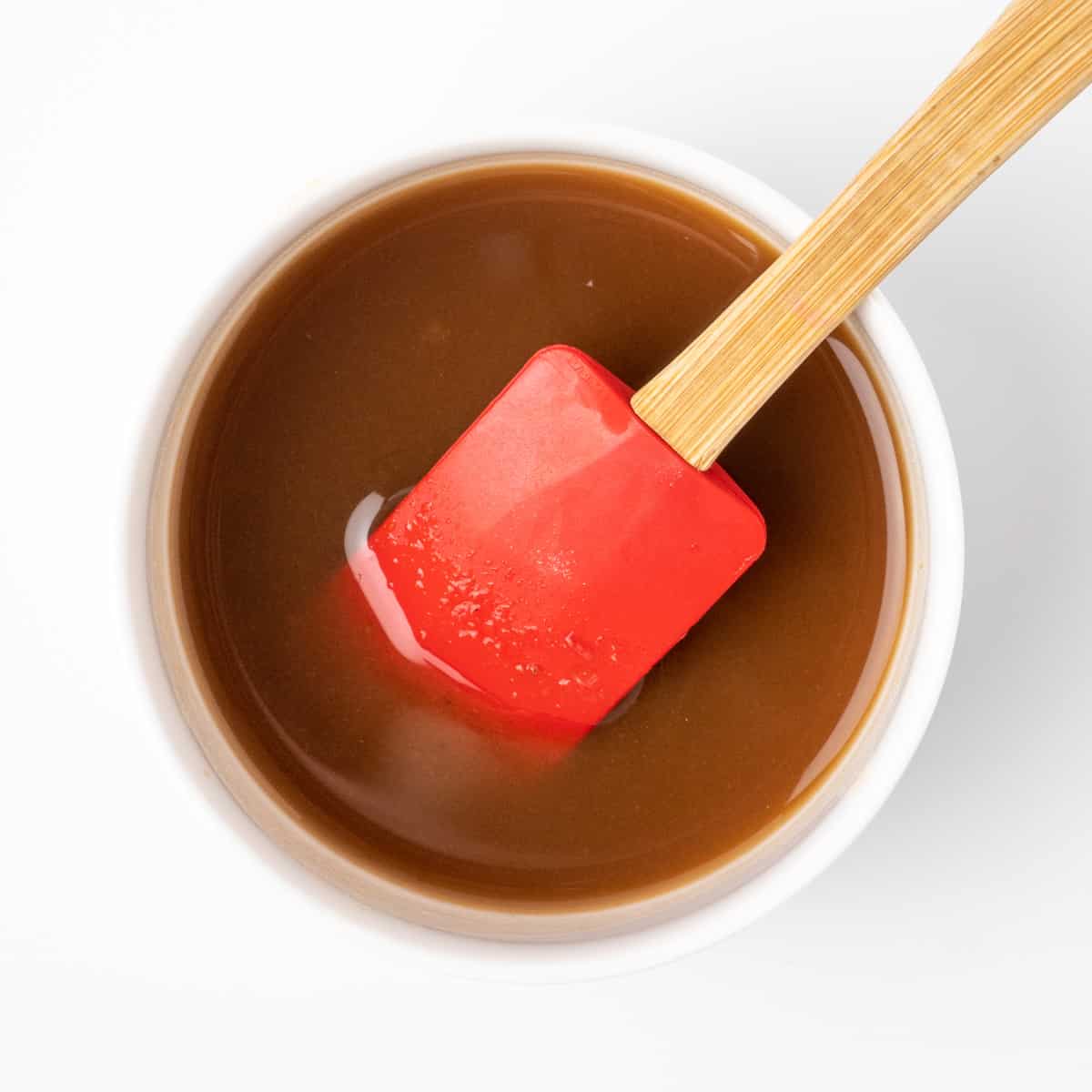
Step 2 - In a small bowl, make the sauce by combining the tamarind, vegan fish sauce and water.
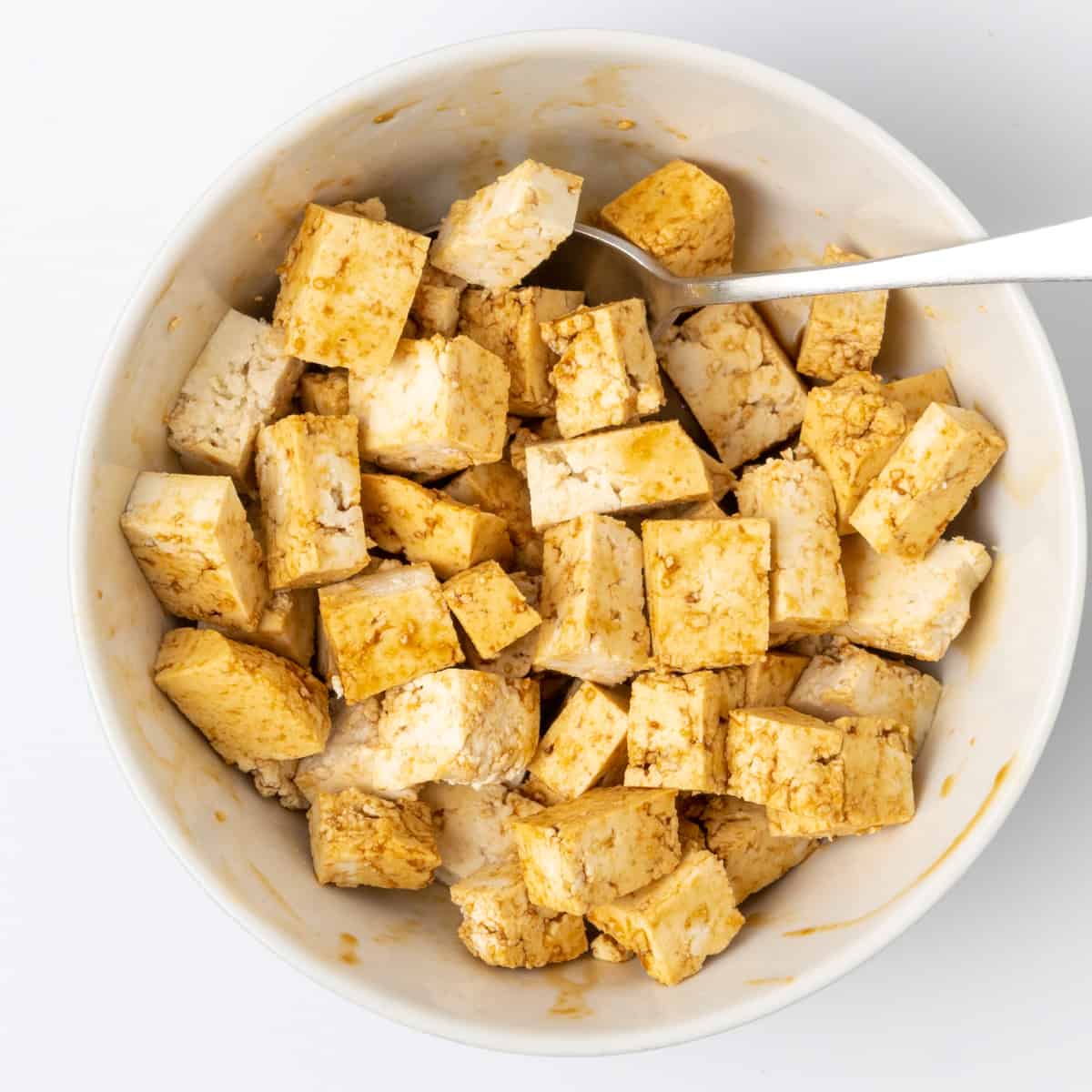
Step 3 - In a small bowl, add the tofu cubes and soy sauce and stir to coat them in the sauce.
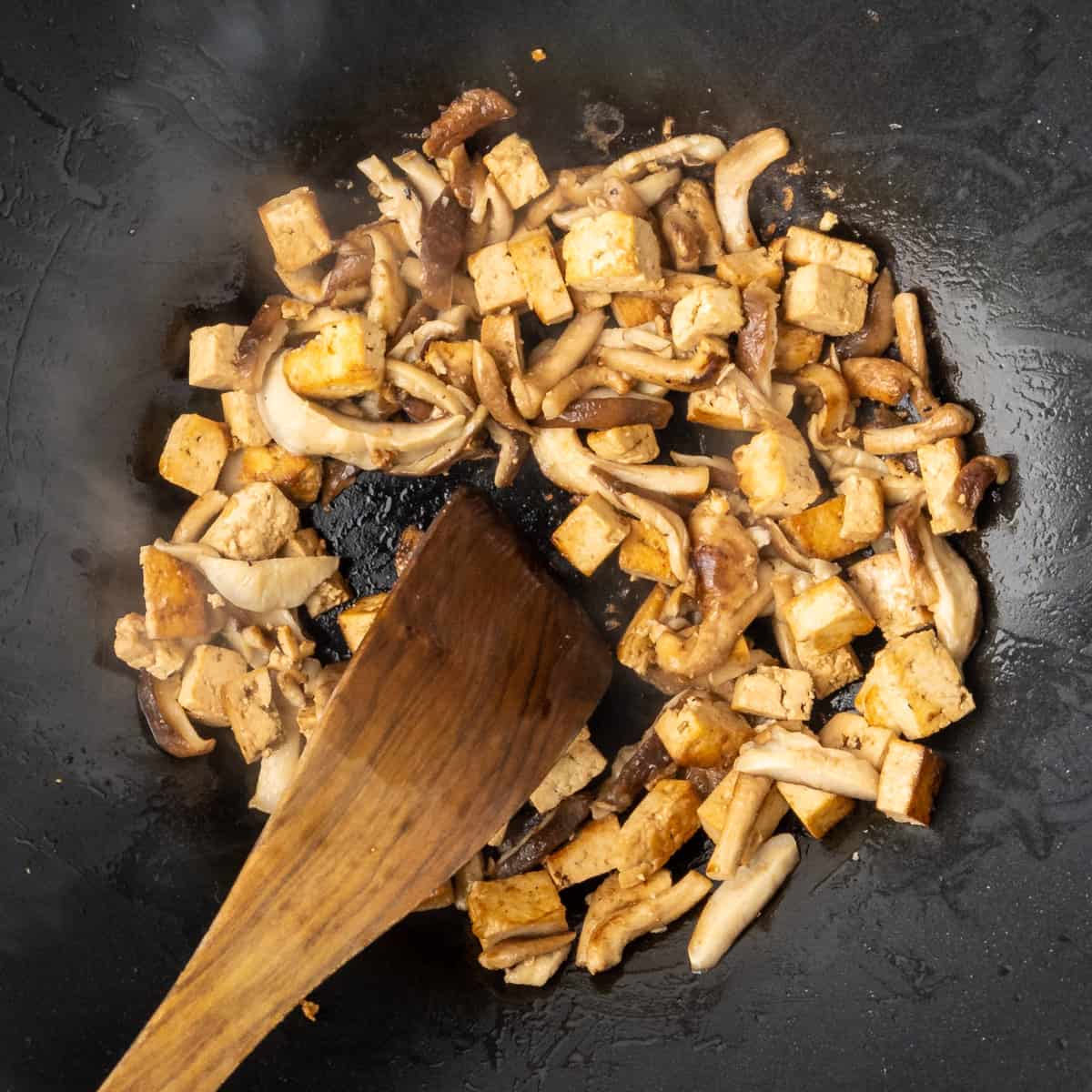
Step 4 - Heat a wok on high heat, add some vegetable oil, the tofu and shiitake mushrooms and stir fry for around 3 minutes until the tofu is golden brown. Set aside the tofu and mushrooms in a bowl.
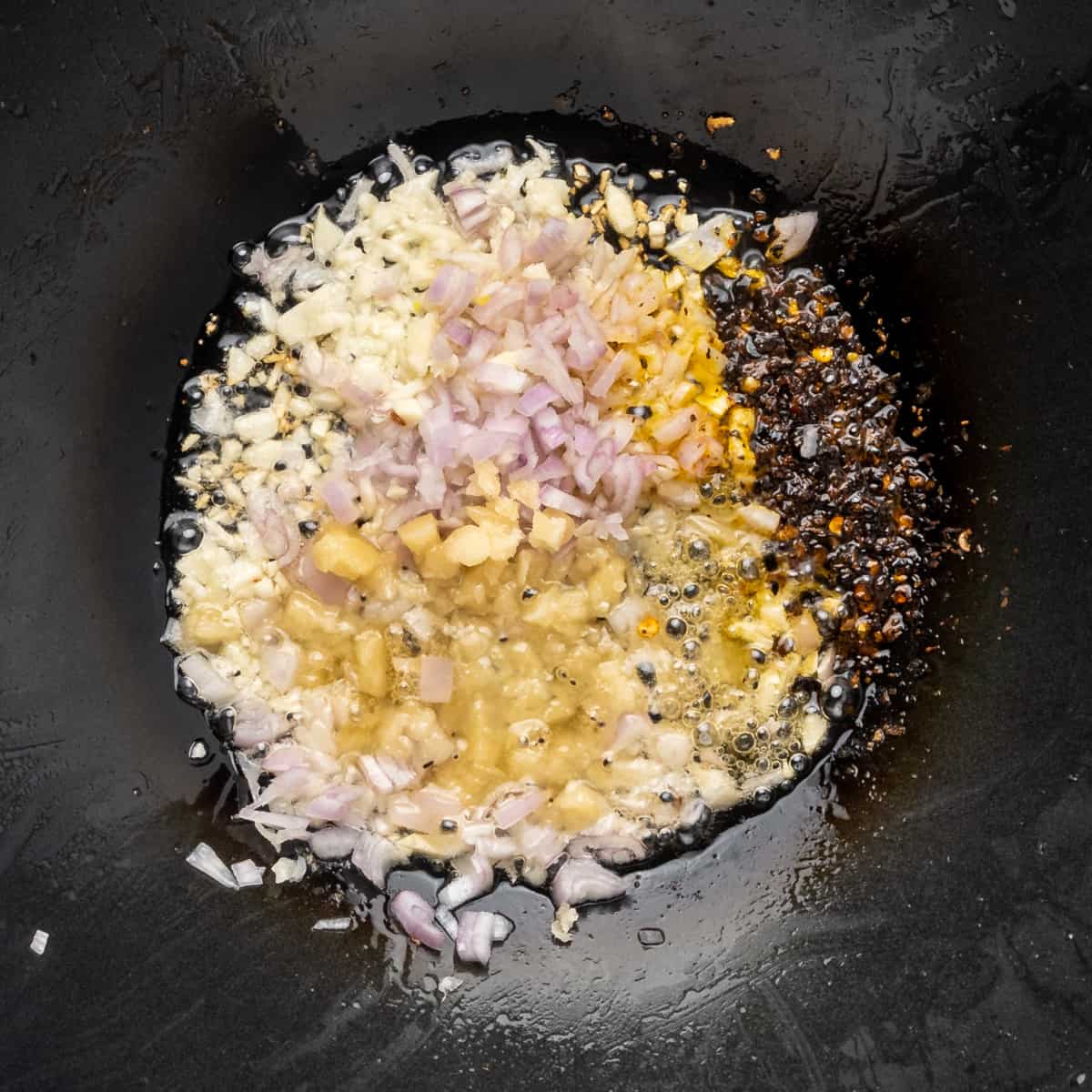
Step 5 - Reduce to medium heat and add more oil, then the shallots, garlic, chilli flakes and palm sugar and fry for around 2 minutes until the sugar has melted.
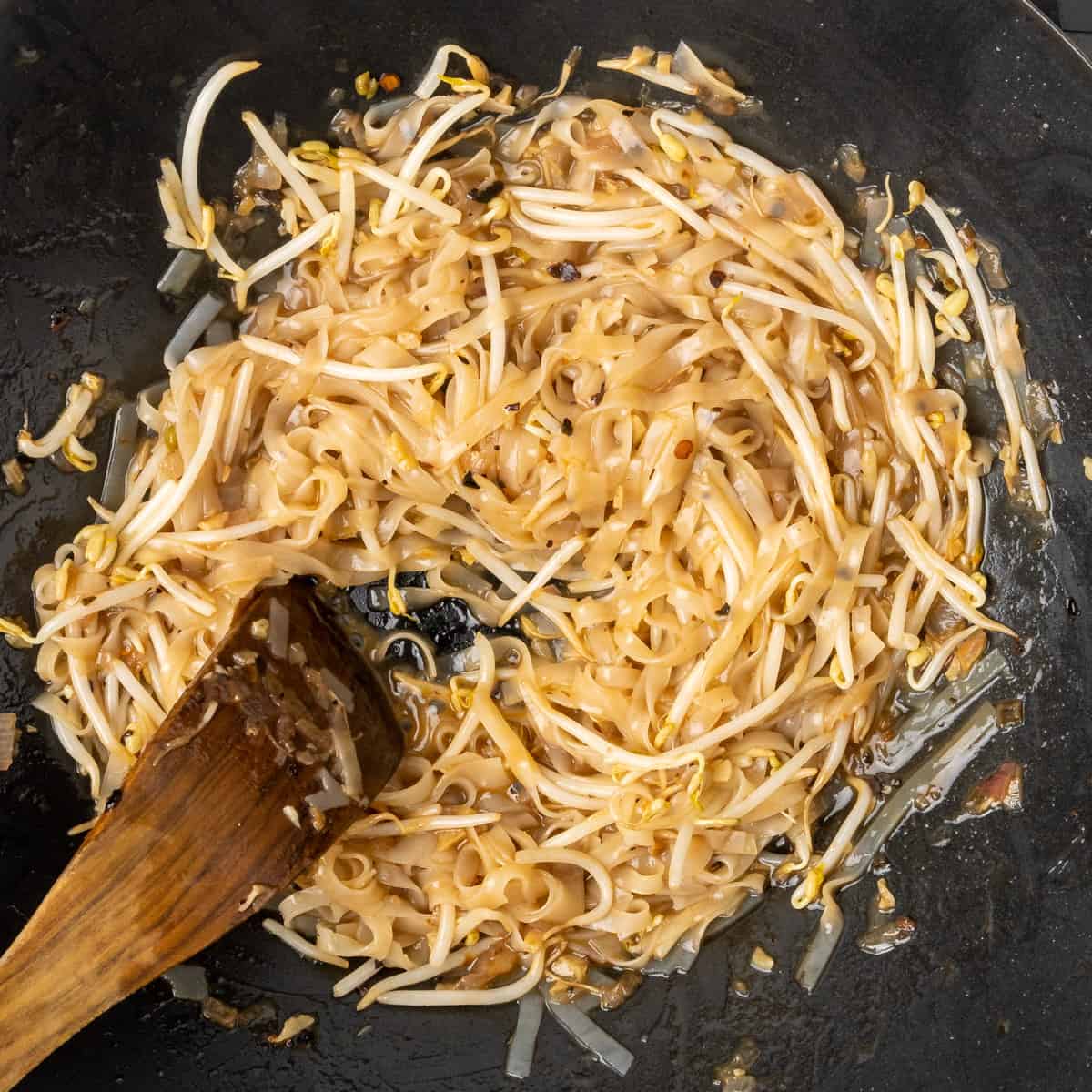
Step 6 - Add the sauce, noodles and bean sprouts. Stir fry on high heat for approximately 2 minutes until the noodles are done and the sauce has cooked down.

Step 7 - Remove the wok from the heat, add the previously cooked tofu and mushrooms, garlic chives and most of the roasted peanuts and stir through to combine.
Variations
Make it gluten free by using a gluten-free tamari sauce instead of the soy, and a gluten-free vegan fish sauce or miso.
For an even more authentic taste, you can add 1 -2 tablespoons of Thai pickle radish.
If you want to make a less traditional pad thai, you can add more veggies such as carrot ribbons or sticks, bell pepper and fresh cilantro.

Serving
In Thailand, it is common to serve pad thai with extra beansprouts. If you want to eat beansprouts raw as a salad, they must be labelled as ready-to-eat. Otherwise, beansprouts must be cooked thoroughly to reduce the risk of foodborne illness.
Pad thai often comes with a small amount of sugar and chilli flakes on the side, so you can season it to your taste.
We also like to serve our pad thai with lime wedges and extra crushed peanuts on top.
Storage
Pad thai is best served fresh.
If you have leftovers, store them in the fridge for up to a day and reheat in a pan with a splash of water, or in the microwave.

More vegan dinner recipes
We hope you enjoy this yummy vegan pad thai for dinner! Try some of our other delicious vegan meals:
📖 Recipe
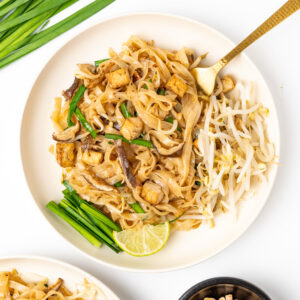
Vegan Pad Thai
Ingredients
- 4 oz (115 g) dry rice noodles medium size or 3mm thick
- 3 tbsp Thai tamarind concentrate adjust to taste, as some brands are more sour
- 2 tbsp vegan fish sauce substitute with 1 tablespoon soy sauce and 1 tablespoon miso paste
- 3 tbsp (45 ml) water
- ½ pack (140 g / 5oz) extra-firm tofu
- 2 tsp soy sauce
- 1 ½ cups (120 g) shiitake mushrooms sliced
- 3 tbsp vegetable oil divided, see instructions
- 1 shallot finely diced
- 3 cloves garlic finely chopped
- 1 tsp dried chilli flakes red pepper flakes
- 3 tbsp (35 g) palm sugar
- 1 cup (115 g) bean sprouts
- 5 - 10 garlic chives cut into 3 cm / 1¼ inch sticks
- ¼ cup (40 g) roasted peanuts roughly chopped
- 1 lime
Instructions
- Soak the noodles according to the package instructions for stir frying.4 oz (115 g) dry rice noodles
- In a small bowl, combine tamarind concentrate, vegan fish sauce (or alternatively soy sauce and miso paste) and water.3 tbsp Thai tamarind concentrate, 2 tbsp vegan fish sauce, 3 tbsp (45 ml) water
- Drain and gently press the tofu, then cut it into small cubes. In a bowl, stir together the cubed tofu and soy sauce.½ pack (140 g / 5oz) extra-firm tofu, 2 tsp soy sauce
- In a wok, heat up 2 tablespoons vegetable oil and fry the tofu and sliced shiitake mushrooms for 3 minutes on high heat. Remove the tofu and shiitake from the wok and set aside.1 ½ cups (120 g) shiitake mushrooms
- Place the wok back on medium heat, and add 1 more tablespoon of vegetable oil. Fry the shallots, garlic, chilli flakes and palm sugar for 2 minutes, until the sugar is melted.1 shallot, 3 cloves garlic, 1 tsp dried chilli flakes, 3 tbsp (35 g) palm sugar
- Add the pre-mixed sauce, noodles and bean sprouts. Cook for about two minutes on high heat, stirring frequently, for about 2 minutes until the noodles are done and the sauce is absorbed or cooked down. You can add a bit more water if necessary.1 cup (115 g) bean sprouts
- Take off the heat, and add the tofu and mushrooms back in, along with garlic chives and most of the roasted peanuts.5 - 10 garlic chives, ¼ cup (40 g) roasted peanuts
- Serve in bowls topped with the remaining roasted peanuts and a wedge of fresh lime.1 lime
Notes
The soaked noodles should be soft and pliable enough to wrap around your finger. This typically takes around 30-45 minutes in room temperature water. Some varieties of noodles can be quick soaked in boiling water for 3 minutes and then rinsed in cold water before using. Roasting peanuts If you roast the peanuts yourself, roughly chop blanched (skinless) peanuts, and spread them out on a baking sheet. Roast them in a dry skillet or a fan oven at 180 - 200℃ (350 - 390℉) for about 3 - 5 minutes. Watch them carefully as they turn quickly once starting to brown. Take them out when they are golden brown. Substitutions For best results we recommend using the ingredients listed. See the post above for a detailed guide to possible substitutions and ingredient tips. Scaling the recipe It's difficult to cook a larger serving size in a wok, so we don't recommend doubling the recipe. If you want to make more portions, you can prepare all the ingredients and then cook and serve in batches. Recipe adapted from Hot Thai Kitchen.
Nutrition
This information is calculated per serving and is an estimate only.


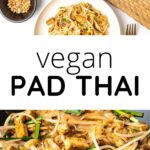
Leave a Comment & Rating